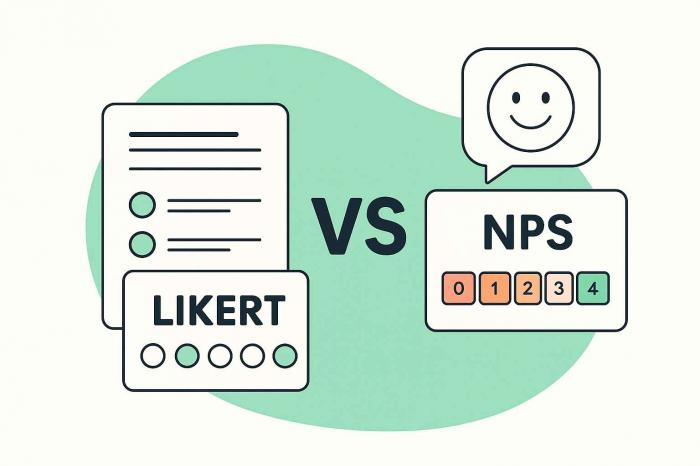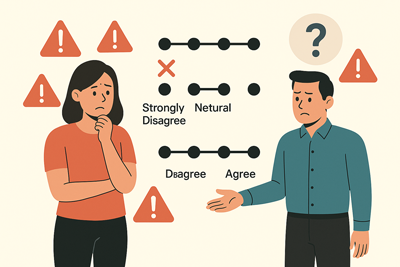5 Types of Survey Questions that Customers are Eager to Answer
 Want your customers to actually answer your survey? Here’s a hard truth: the problem isn’t always with your customers—it’s with your questions. Stop blaming low response rates on “busy people” or “bad timing.” The truth is, if your questions don’t interest your audience, they’ll simply ignore them. But don't worry—here’s exactly how you can change that!
Want your customers to actually answer your survey? Here’s a hard truth: the problem isn’t always with your customers—it’s with your questions. Stop blaming low response rates on “busy people” or “bad timing.” The truth is, if your questions don’t interest your audience, they’ll simply ignore them. But don't worry—here’s exactly how you can change that!
Surveys are powerful tools for understanding your customers' needs, preferences, and behaviors. But here’s the catch: even the best-designed surveys are useless if no one answers them. The key to getting responses isn’t just about distribution—it’s about the questions themselves. You can’t expect a customer to engage with a survey full of irrelevant, confusing, or boring questions. Think about it: if you’ve ever received a long, complicated survey, how did it make you feel? Frustrated, right?
Choosing the right questions means you respect your customer’s time and show that their feedback is genuinely valued. When you craft questions carefully, you increase your chances of getting not just more responses but also meaningful responses. And here’s why that matters: meaningful responses give you actionable insights. With those insights, you can make informed decisions to improve your product, service, or customer experience. When you ask the right questions, you turn your survey into a powerful tool for growth. It’s like digging for gold—you won’t find treasure if you don’t know where to dig.
On the flip side, using the wrong questions can backfire. Vague or biased questions will only frustrate your customers and skew the results, leaving you with unreliable data. Worse, poorly designed surveys can even damage your brand’s reputation. Customers might view you as disorganized or out of touch with their needs if you bombard them with irrelevant questions. So, how do you avoid these pitfalls and get customers excited to answer your surveys? Here’s the roadmap.
5 Types of Survey Questions that Customers are Eager to answer
Here are 5 types of questions customers are most eager to answer, especially when they see the value their answers provide:
1. Experience-Based Questions
Customers are often willing to share their personal experiences, especially when they feel heard. Experience-based questions invite them to reflect on how they interacted with your product, service, or team. These could range from their onboarding journey, a recent purchase, a support interaction, or how the product fits into their daily routine. When framed well, such questions help you uncover valuable stories and identify customer pain points or moments of delight. For example, asking “Can you tell us about a time our product helped you solve a problem?” not only makes the customer feel valued but also gives you a chance to gather testimonials and case studies for marketing purposes.
2. Quick Rating or Scale Questions
These are typically the most frictionless types of survey questions and include formats like 1–5 stars, emoji-based reactions, or scales (e.g., 1–10 for NPS). They're effective because they require minimal time to answer, yet they give you quantitative data to track satisfaction over time. For instance, the Net Promoter Score (NPS) question “How likely are you to recommend us to a friend or colleague?” has become a global standard for customer loyalty measurement. These questions are especially valuable for spotting trends, segmenting users based on satisfaction levels, and identifying opportunities for follow-up.
3. Feature or Preference Questions
These questions help you understand what your customers truly want from your product. Instead of guessing or building features based on assumptions, you can involve your users directly in the product development process. Asking “Which feature would make your experience better?” or “Would you prefer a dark mode interface?” gives customers a sense of ownership. They become co-creators rather than just users. When customers feel that their opinions shape the product, they’re more likely to stay engaged and loyal. These questions also serve as a great foundation for building a user-driven roadmap.
4. Binary Yes/No Questions
While they might seem overly simple, binary questions like “Did you find what you were looking for today?” or “Was this page helpful?” are powerful because they are easy to answer and ideal for micro-moments in the user journey. They're particularly useful when you want to evaluate specific interactions, such as navigating a knowledge base, completing a transaction, or using a feature. These yes/no formats can be strategically placed across your platform to gather passive feedback without overwhelming the user. Despite their simplicity, they can signal when something’s broken—or working really well.
5. Value-Oriented Open-Ended Questions
These types of questions go beyond satisfaction; they tap into the emotional and practical value customers derive from your offering. When you ask a question like “What’s the biggest benefit you’ve received from using our service?”, you’re encouraging reflection and helping customers articulate their success. This not only helps with brand positioning and marketing, but also provides real feedback on your unique selling proposition (USP). Another great value-oriented prompt is: “If our product stopped working tomorrow, what would you miss the most?” Answers to such questions highlight the true value of your product in real-world usage and give you powerful language to use in your sales and onboarding content.
Steps in Choosing Survey Questions
If you want customers to be eager to answer your survey, you must be strategic in crafting the questions. It's not just about what you want to know; it’s about what they want to share. Follow these simple, straightforward steps to make your surveys something they actually want to complete.
Understand Your Audience
Imagine asking a 50-year-old about high school trends. It wouldn’t work, right? Your questions must match your audience’s interests, knowledge, and experiences. Before you write a single question, know who you’re talking to. Think about their age, interests, job, and experiences. This way, you’ll create questions they can relate to, which makes them more likely to respond.
Research shows that personalization and relevance increase survey response rates. If a customer feels like the questions are targeted directly at them—based on their preferences or past behavior—they’re more likely to engage. For example, instead of sending the same generic survey to all your customers, segment your audience and ask questions that are specific to their demographic or interaction with your brand. It shows that you’re not just asking for the sake of asking but truly value their input.
Keep Questions Simple and Clear
Here’s a golden rule: if someone needs to read your question twice, it’s too complicated. Use plain, everyday language. You don’t need big words to sound smart—you need clarity to get answers. Studies show that people are more likely to complete surveys when the questions are short and easy to understand. For example, instead of saying, “To what extent do you find our services beneficial in your daily business operations?” simply ask, “How helpful are our services?”
Clarity is king. The clearer your question, the less mental effort it requires to answer. This is crucial because surveys should feel effortless. The moment a customer feels like they need to put in too much work to understand or answer your question, they’re more likely to abandon the survey altogether. Make it easy for them—use simple, direct language, and always be mindful of your audience’s reading level and familiarity with certain terms. If you are finding it hard to get simple questions, just use the templates on Enquete
.
Ask Relevant and Purposeful Questions
Every question you ask should have a reason. Don’t throw in random questions just because you’re curious. Imagine filling out a survey about your favorite clothes, then suddenly being asked about your thoughts on home appliances. Weird, right? Keep every question relevant to the main purpose of your survey. If customers feel like your questions are directly tied to their experience or needs, they’ll be more willing to answer.
Harvard Business Review notes that customers are more likely to respond to surveys that ask questions directly related to their recent experiences. If you’re gathering feedback on a new product, for example, your questions should revolve around that product—its quality, usability, and any improvements needed. Keep your focus narrow, and your respondents will feel that their feedback is truly valuable and useful.
Balance Between Closed-Ended and Open-Ended Questions
Too many open-ended questions are exhausting. People love clicking boxes and rating things—it’s fast and easy. Closed-ended questions, like multiple-choice or rating scales, give you specific answers without much effort from the respondent. On the other hand, one or two open-ended questions can provide richer feedback, like “What’s one thing we could improve?” But don’t overdo it—asking too many open-ended questions can lead to survey abandonment.
There is a secrete to choosing the right question type. Balancing the types of questions is critical. Closed-ended questions offer quick wins for both the respondent and your data analysis. But the occasional open-ended question allows your customers to express their thoughts freely, which can uncover insights you may not have anticipated. Be strategic: ask closed-ended questions for the bulk of the survey, and sprinkle in a few open-ended ones to capture deeper insights.
Avoid Leading and Biased Questions
No one likes to feel tricked or guided toward a specific answer. If your questions feel like you’re fishing for compliments, you’ll lose trust. For example, asking “Why do you love our product?” assumes they do love it (but what if they don’t?). Instead, ask neutral questions like, “How do you feel about our product?” This way, you’ll get honest feedback instead of skewed data.
Leading questions not only irritate your customers but also lead to misleading data. Instead of helping you understand what your customers truly think, these questions push them toward a specific answer. Avoid phrases that assume positive opinions or suggest the "right" answer. Stay neutral, and you’ll get more genuine, useful responses.
Offer Incentives for Completing the Survey
Everyone likes rewards! Research shows that offering small incentives, like a discount code or entry into a giveaway, can boost survey response rates by up to 30%. But here’s the catch: make sure the reward doesn’t sway their answers. You want honest feedback, not people filling out the survey just to get a prize. Keep the incentive small but meaningful.
Incentives are a powerful motivator. A study by SurveyMonkey found that people are more likely to complete surveys when there’s something in it for them. It doesn’t have to be extravagant—a small gift card, discount code, or entry into a prize draw can be enough to encourage participation. However, always ensure the incentive isn’t so big that it compromises the quality of the feedback.
Test Your Survey Before Sending
Before you send your survey to thousands of customers, test it on a small group. Ask colleagues or a small sample of your audience to complete it. Pay attention to where they pause or ask questions—those are signs of confusing or unclear wording. A quick test will help you spot problems and refine your questions so they make sense to everyone.
Running a pilot test is like proofreading an important paper—you don’t want to send out a survey with mistakes. By testing your survey with a small group, you’ll catch any issues that might confuse or frustrate respondents. This step ensures that your final version is polished, easy to understand, and ready for success.
Quality Questions Lead to Actionable Insights
Your survey questions are your secret weapon for understanding your customers. Well-thought-out questions lead to more responses, and more responses mean better insights for your business. Follow these steps, and you’ll create surveys that not only get answered but also give you the feedback you need to make better decisions. Remember, if you want answers, you have to ask the right questions!


